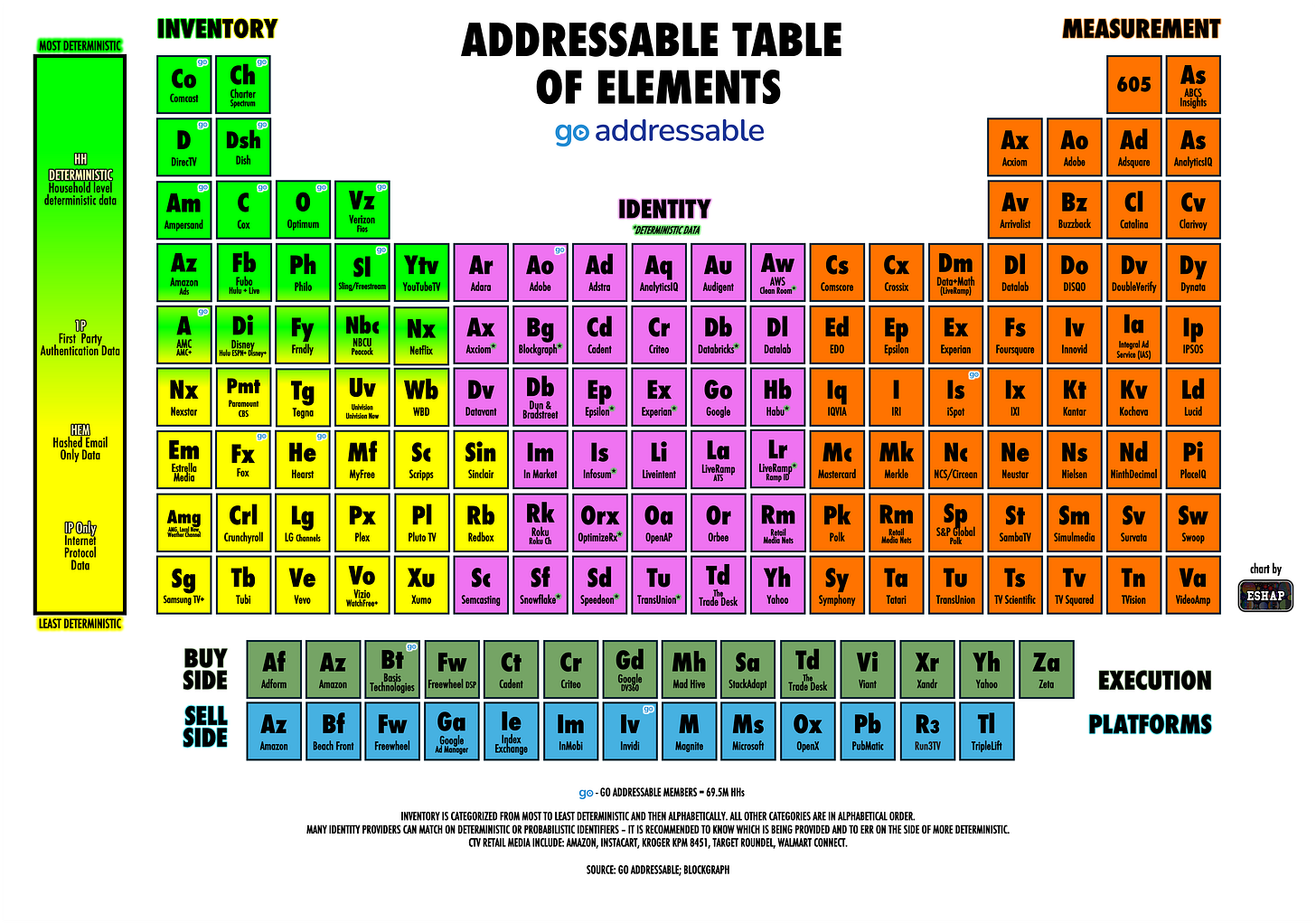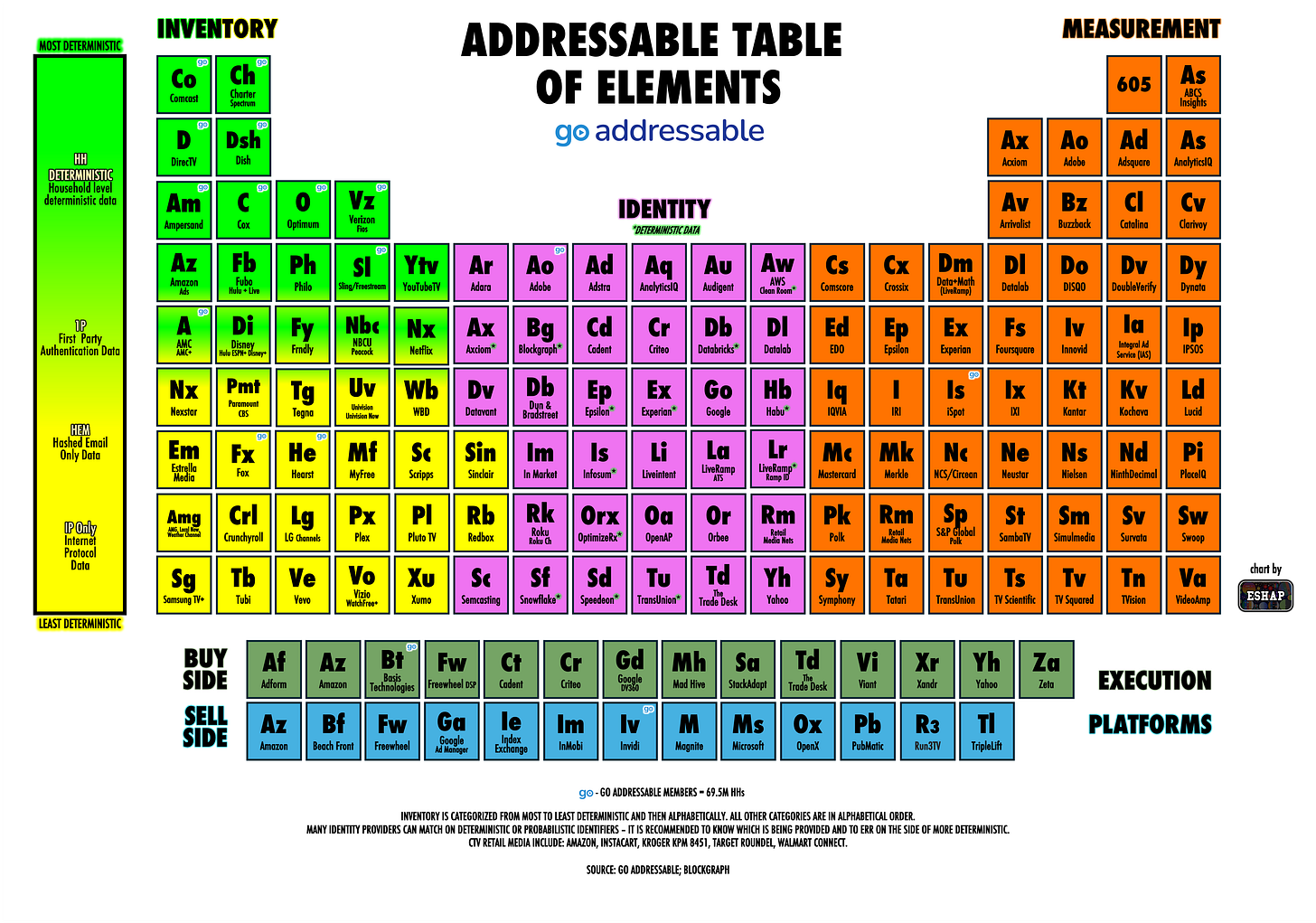PUBLIC ADDRESSABLE
WHY THE BEST DATA WINS
Happy Thursday Peaceniks. Are you ready to be addressed‽
Above is my latest chart of the Media Universe and my latest collab: The Addressable Table of Elements. This table - a collaboration with Go Addressable - represents all the players and platforms in the Addressable Advertising Universe.
Why? Because, contrary to conventional advertising wisdom…
Programmatic buying is now the antique wooden crutch propping up old-school thinking in TV advertising. It’s also a key factor preventing more money from migrating to Connected Television.
Does it help automate buys? Sure. But programmatic advertising is also about as transparent as dry cement. These aren’t my sentiments, they come straight from the minds and mouths of the people who spend the friggin’ money.
“We’ve been handicapped as marketers by not having enough information to tell a positive story around what CTV is bringing to the bottom line.”
- Agency Exec at Digiday Programmatic Summit
“The lack of transparency flies in the face of how we should attract Media buyers to CTV.”
- Agency Head, to Ad Exchanger
The biggest issue facing CTV advertising right now is crappy data - on both ends of the buying spectrum. Targeted audiences are sold in bulk like tube socks at Costco, while backend results are muddier than the Redneck Yacht Club. Meanwhile, a major lynchpin of the ad economy, IP Addresses, get less and less reliable everyday.
Data vendors collect and resell IP addresses like kids with Pogs on the playground (dated reference, sorry). That’s their business. But it’s not really their business to invest resources into vetting the accuracy of those IP addresses. That would hurt their margins.
CIMM and Truthset are currently studying IP datasets to assess their reliability. They have found that commercially available IP address datasets are a far cry from accurate. There is no standard for IP sourcing methodologies across the industry’s vendors. Therefore, the accuracy and inaccuracy of IP address data varies widely from venor to vendor - and even within any single provider’s datasets. VPNs artificially inflate IP-sharing. None of the vendors seem to understand how to deal with multi-dwelling units so prevalent in the largest and most densely concentrated markets in the US. As a result…
The average vendor now estimates four or more IP addresses per household address, compared to ISPs (the actual providers of internet to homes) with an estimated average of just 1.3 actual IP addresses per home.
Meanwhile, new data from Innovid projects that the average ad campaign on CTV reaches just one-in-five homes in the CTV universe - missing more than 80% of the American CTV ecosystem. A good deal of this miss and/or waste (over frequency to certain homes while badly whiffing other dwellings) is due to plain old shitty data. As is the rising tide of fraud.
On one hand, most buyers - nearly two-thirds - seem entirely unconcerned with fraud on Connected TVs.
On the other, more than $90 billion dollars will be wasted on CTV this year, playing ads for bots rather than humans. And that figure will grow to more than $170 billion in wasted ad time by 2028.
And that, my advertising friends, is what comes from an over-reliance on programmatic buying and IP addresses, rather than doing all the homework with high-quality household level data. In short: IP addresses are not reliable. Even hashed emails (email addresses scrambled for privacy) are often far less accurate than you’d want them to be (considering the cost). Why? Think about how many one-time emails you’ve used to sign up for shit or how many old work emails you no longer use. Now do the math.
If this frustrates you, don’t get Mad, Man. Get Deterministic.
Deterministic data is information that is known/proven to be true and accurate - based on unique identifiers that match an actual human with the corresponding deets. These are known email addresses, known phone numbers, known credit card numbers, known usernames and specific customer IDs. Think about the relationship between an internet provider and the customer. That billing relationship must be based on provable, accurate data like those listed above. Otherwise, nobody in that home gets on the internets tonight.
And that high-quality, provably accurate, reliably maintained zero-party, household level data - properly anonymized for privacy protection - is what makes Addressable Advertising an actual data strategy; versus the rote, opaque, increasingly inaccurate process of Programmatic ad buys.
Does this mean you should exclusively use deterministic household level data when you buy Media? That may not always be possible, depending on the scale of your buy. A mix of deterministic and probabilistic is likely more scalable. However, in the studied opinion of this Media Cartographer, to ensure the greatest transparency, the highest level of accuracy, and the best return on your marketing investment, you should always start with platforms that offer deterministic data. Why?
If, like most buyers right now, your top Media priorities are Outcome and Value, then you need the best data from the most reliable partners and platforms. A clean room can’t clean up the mess from wonky IP addresses and defunct emails. And you won’t see that mess until you step in it - after your campaign has run.
Who are the best partners? From whence does the best data come? How do you navigate the Addressable Universe? That’s precisely what the Addressable Table of Elements is for!
The table shows you all of the players, platforms, elements and variables that make up Addressable Advertising. For the most part, the table is entirely agnostic towards the providers charted. The one exception: The quality of the data offered by those providing the inventory. If you want to know that your marketing money is not being wasted, look to where the scale is greenest - and most deterministic. The further down that scale you go, the more harshly the table blinks yellow - the less reliable and transparent the data and results will be in return.
Thanks to Go Addressable for this fun, colorful, and educational collab. I failed chemistry badly in high school and I think I can use this new chart for extra credit.
Enjoy the weekend!
ESHAP











